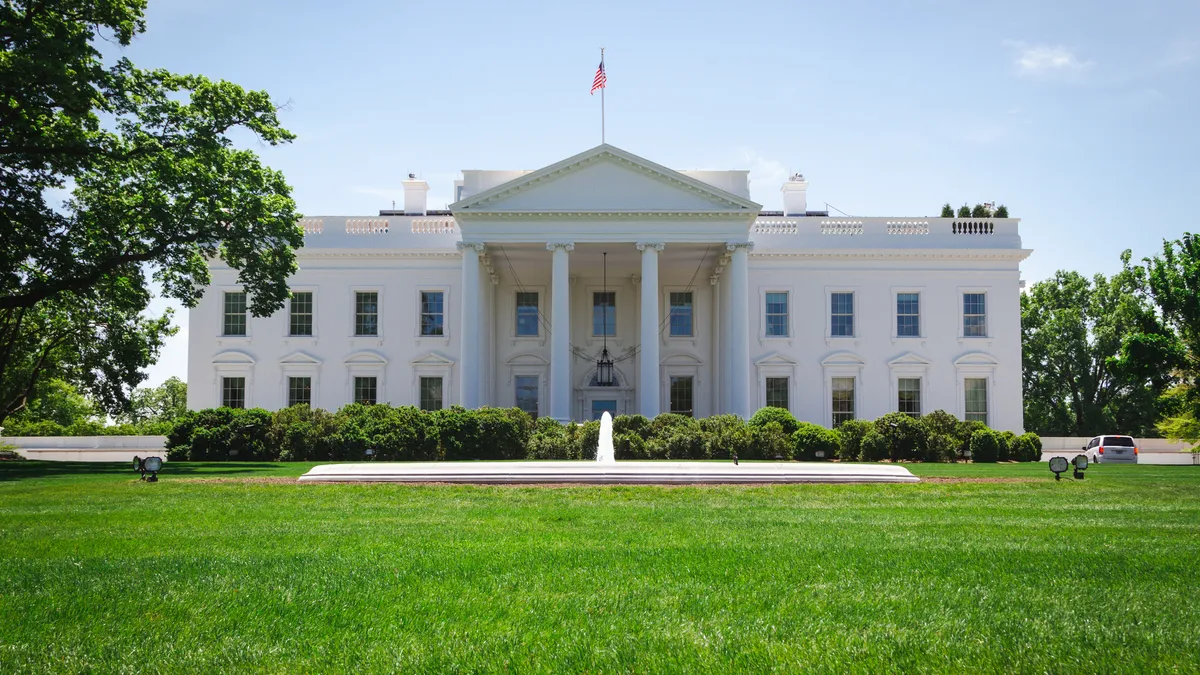Dive Brief:
- The federal government plans to define what a “zero-emissions” building is as part of a push to address the building sector’s contribution to climate change.
- The proposed definition will rest on a three-pillared approach to building decarbonization: an adherence to stringent energy-efficiency guidelines, the use of 100% clean energy and a requirement for buildings to refrain from generating emissions on-site, White House National Climate Adviser Ali Zaidi announced Sept. 28.
- The definition is part of the Biden administration’s effort to establish uniform guidelines in an industry that accounts for roughly a third of the country’s annual greenhouse gas emissions, according to calculations from the U.S. Environmental Protection Agency.
Dive Insight:
The Biden administration is proposing a “holistic federal definition” that “can provide a unifying guidepost for real estate professionals to strive for zero emissions over time,” said Duane Desiderio, senior vice president and counsel at the Real Estate Roundtable, which represents real estate firms and trade associations. The three-pillar approach “addresses both megawatts of energy use avoided by building owners, tenants and other occupants as well as new renewable energy generation,” he said.
The zero-emissions definition will most likely come from the U.S. Department of Energy, according to Liz Beardsley, senior policy counsel at the U.S. Green Building Council.
“Given the conversations taking place around net-zero emissions, what the White House has realized is that there’s a need to have a common definition that the market can align [with],” Beardsley said in an interview after the announcement at the Greenbuild International Conference and Expo Sept. 28. The three pillars, she noted, would come into common use and drive the industry toward core strategies that help buildings achieve net-zero emissions. Investors, financiers, real estate companies and facilities managers would then have ''that common definition to understand where a given portfolio is with zero-emission buildings,” she said.
The DOE plans to publish the definition in January 2024 after a series of stakeholder engagement meetings aimed at hashing out various components of the definition, including what on-site emissions means, what energy-efficiency targets existing buildings will need to meet and what counts for 100% clean energy, said a White House official. The official, who spoke on the condition of anonymity as they are not authorized to comment on the details publicly, added that the definition will most likely be verified using the U.S. Environmental Protection Agency’s portfolio manager tool.
William Leddy, vice president of climate action for the American Institute of Architects California, said that while his organization is “delighted” to have the new federal definition, “Unfortunately, with the climate emergency accelerating at a disastrous pace, definitions aren’t enough. … We are all contributing to the existential threat of climate change, and we must all work to rapidly decarbonize the built environment.”
In the absence of a national definition, certain states have independently established their own regulations for sustainable buildings. For instance, California’s Climate Corporate Data Accountability Act, passed on Sept. 12, will, if it becomes law, require companies to report emissions from their energy use and operations starting in 2026. By 2027, companies will also need to report emissions from their supply chain and other scope 3 emissions outside of their operations. Likewise, New York City unveiled a plan to support a proposed rule for implementing a landmark 2019 law, which requires buildings over 25,000 square feet to report their greenhouse gas emissions to the city’s Department of Buildings starting May 1, 2025.
“Individual states like California and New York will continue to legislate urgent change,” Leddy said, “but we need even more action from the federal government to build a resilient future for all Americans.”
The proposed zero-emissions definition is not legally binding, according to James Coleman, a nonresident senior fellow at the American Enterprise Institute, and states may not immediately embrace a single federal blueprint. “A lot of the new building construction is taking place in states that would be likely to not go along with any of the recommendations coming out of this proposed definition,” Coleman said in an interview. “And it’s harder for existing buildings to meet any kind of newer energy efficient standards. They’re facing really difficult trade-offs — how much they must invest in adopting more efficient, but more expensive, technology.”
However, energy efficiency is an important area of focus because it reduces reliance on the grid, Kailash Viswanathan, director of energy at Consigli Construction subsidiary Arch Energy, told Facilities Dive. “When you reduce, recover and electrify, you’ll get to a point where carbon emissions in your building go down. The electric grid that provides you the electricity may still be providing electricity generated from fossil fuels. [The question is] how we can make that greener,” Viswanathan said.













